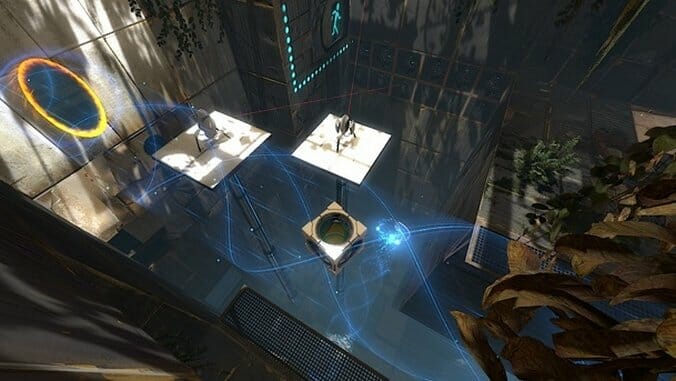Portal 2
(Multi-Platform)

There has been some discussion about whether or not Portal 2 was “necessary.” Its predecessor was a damn-near-flawless gem of a puzzle game, and a big part of its not-inconsiderable charm was its brevity and focus. Portal‘s core concept was simple—players were tasked with overcoming obstacles by using a gun that opened teleport-holes in walls and floors—but its design was remarkably tight and it featured one of the most hilarious and memorable videogame antagonists of the last decade. Even for a studio with a track record as spotless as Valve’s, elaboration upon such a delicate formula could easily lead to overindulgence.
So it’s up to us to figure out how to piece things together. But once we’ve done so, the act of setting the whole thing into motion…
Sussing out and then throwing oneself through Portal 2‘s elaborate physics puzzles would probably be fun enough on its own, but Valve has also seen fit to include a two-player cooperative campaign complete with a separate story and unique puzzles. Suddenly, the testchambers get a lot more complicated…
And then there’s the dialogue and the story, both of which are supremely enjoyable on their own merits and even better in the context of the game. While the surface-level narrative is a bare-bones “Get from Point A to Point B Without Dying” kind of thing, beneath it lies a more abstract parable rife with symbolism and broader themes (no, really)—mother/daughter competition, paternal alienation, the cycle of death and rebirth, the hubris of scientific ambition, and the trustiness of the humble household potato.
The script is uncommon in its sure-footedness and humor, but Portal 2‘s voice-over performances are nigh-on peerless, particularly that of The Office co-creator Stephen Merchant. I suspect that I was not alone in my tendency to stand still for minutes at a time with a grin on my face, listening to him prattle on about the ins and outs of Aperture Laboratories.
Merchant’s character Wheatley is basically a floating robotic eye, and so is brought to life with simple, creative animation and no lip-synching. That appears to have freed the actor up to add as much flavor and ad-libbing to his performance as he deemed necessary. His timing and vivacious delivery are so relaxed and capable that one can’t help but bemoan how drab most videogame voiceover performances are by comparison. Merchant will no doubt forever be associated with Portal 2, perhaps even more so than its manipulative antagonist GLaDOS, despite Ellen McLain’s excellent reprisal of her now-famous role.
With all that taken into account, Portal 2 actually starts to feel a little more like this:
No wait, weird, that’s actually kind of weird. Er, and besides, when it comes down to it, Portal 2‘s greatest love is not for its script, its puzzle design, its characters or its mysterious universe; this is a game that loves The User.
But then, what does it even mean for a game to be necessary? Let there be no doubt, Portal 2 is a superbly crafted, joyous experience, a loving tribute to creative design, problem solving, and the remarkable flexibility of the human mind. Its puzzles are clever and for the most part immaculately constructed, and Erik Wolpaw, Jay Pinkerton and Chet Faliszek’s script earns the game a place alongside the very funniest of all time. I’d say that by any possible metric, Portal 2 was absolutely necessary.
The word “necessary” is, of course, a bit loaded. Unlike a certain robot in Portal 2, we humans are not actually addicted to the pleasurable bursts of dopamine granted by solving a tricky puzzle. But by the end of the ten or so hours it took me to work through the single-player campaign, I might as well have been. One minute I’d be standing still, looking from wall to wall while scratching my head, and then… something would click. Moments later I would be soaring through the air towards my next goal, grinning like an idiot while feeling smarter than hell.
The goal of many current-generation games seems to be to minimize the distance between the player and the world as much as possible, to erase the hand of the maker and fool us into believing that we are actually experiencing the events on the screen. But Portal 2‘s beautiful puzzle design exists in plain sight, just beneath the surface. Throughout my time with the game, I was constantly and happily aware that I was progressing through a series of man-made obstacle courses.
In fact, my joy at solving a puzzle was often accompanied by an admiring nod to the men and women at Valve who engineered it. What’s more, the presence of a deep and insightful developer commentary track makes a second playthrough of the single-player campaign worth embarking upon, and is further evidence of Valve’s commitment to articulate, clear-eyed game design.
“But how does the game play?” you may be asking. Well, it’s a little bit hard to describe the actual flow of Portal 2, so I picked up my camera and put together some (highly scientific) visual aids.
The first thing to realize is that when broken down to its mechanical fundamentals, each puzzle in Portal 2 looks more or less like this.


